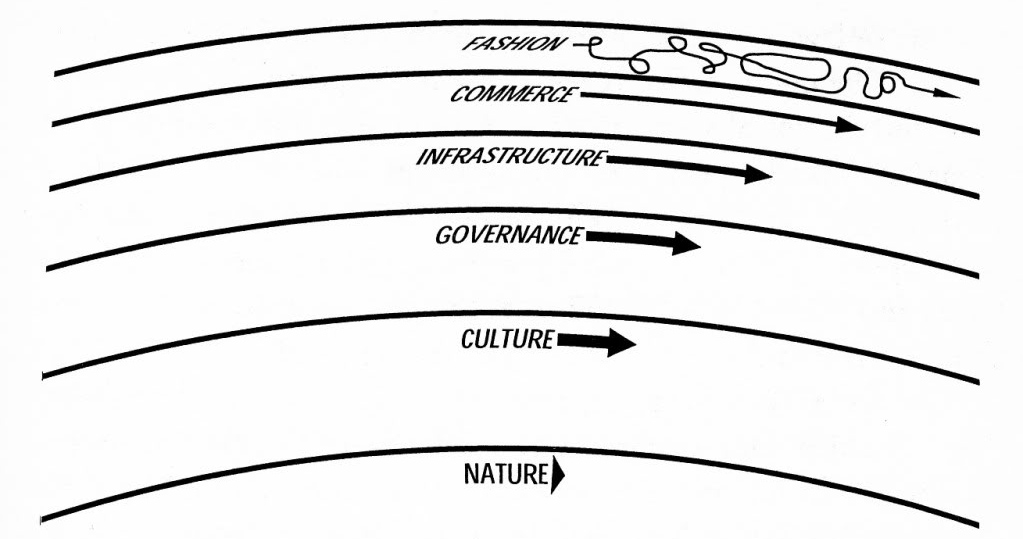Will #coworking exist in 10 000 years? Slow the pace, it’s not a race
Technology has accelerated the speed at which we are living and communicating with each other. Just like a Twitter feed, what happened yesterday is already old news. Sometimes we need to stop and mull things over to have a wider perspective. Recently, while reading the book The Clock of the Long Now by Stewart Brand, I came across one of its best known diagrams, which I believe could help us analyse or look back on the last 10 years of the coworking movement. Stewart Brand separates civilisation into six different layers, each of which changes at its own speed. For example, there is a significant gap between the almost ethereal tempo at which fashion moves and the rhythm of nature.

Pace Layering. Source: The clock of the long now.
Over recent years, the coworking movement has significantly gained momentum and the question is often asked as to whether this "hype" is positive or if it could negatively affect the sustained/sustainable growth of coworking spaces, culture and coworking community.
Do you remember cybercafés? If you were to ask a 15-year-old, I doubt they would know what you're talking about, but there were loads of them back in the day. The introduction of home broadband had a great impact on their model. Models such as Blockbuster didn't know how to respond to the Internet boom either.
Stewart Brand is co-founder of the Long Now Foundation, which mainly considers fostering long-term responsibilities for human kind. In this scenario, they have projects such as the 10 000 year clock or using genetic engineering to clone a mammoth.
- What percentage of the population will be working in 1 000 years' time?
- How much of the active population will be employed and how much of it will be freelance?
- How many cities/planets will a person born in 2 000 years live in?

- Work environment: a shift from an employee culture to "self-driven" people, end of the work/life balance, mobility.
- Changes to city models: independence on transport methods, new housing models, redefinition of public space.
- Consumer models: increase in shared economy, more efficient and rational resource usage models.
- Family environments: changes to traditional models, coliving, family conciliation.
Do you think that coworking will exist in 10 000 years' time?
Related stories
Global Coworking Trends and Opportunities for 2025
Now well into 2025, the coworking industry continues to demonstrate strong momentum. With demand for coworking spaces remaining steady around the globe, it's clear that coworking is not just enduring—it's thriving. Let’s explore the major trends and opportunities shaping the global coworking landscape this year.
Creating Events that Drive Community Engagement in Coworking Spaces
Community is everything in coworking, but a genuine sense of connection between members doesn’t magically happen overnight or by chance. Often, meaningful relationships take intentionality, effort, and time to build, with events being an effective vehicle for bringing people together around shared interests, goals, and experiences, creating opportunities for collaboration, and a thriving coworking culture. This article looks at creating events that drive community engagement in coworking spaces.
Liz Elam: ‘Community is the number one amenity in coworking spaces’
A household name in the global coworking industry, Liz Elam, is the founder of one of the world’s best coworking event series: GCUC. Liz’s coworking roots began in 2010, when she established Link Coworking – a welcoming, affordable, and professional coworking space – in her hometown of Austin, Texas. Link Coworking achieved incredible success, expanding across three locations and becoming the fourth-largest coworking brand in Austin. It was sold in 2019, making Liz the first woman globally to exit a coworking brand.
Key Takeaways from the Coworking Alliance Summit 2025
Gathering online for the Coworking Alliance Summit last week, members of global coworking alliances, coworking spaces, and community leaders came together to navigate global issues, strengthen ties across the coworking industry, and work collectively towards future goals.
5 Ways to Reduce Noise in Open Offices & Coworking Spaces
Some people like working against a background of noise, while for others it’s their worst work nightmare. The truth is, our relationship with noise depends on our own preferences and the nature of our work.
Key takeaways from the Workspace Design Show 2025
London’s Workspace Design Show is undoubtedly one of the best coworking events of 2025. For one, the exhibition (held at Islington’s Business Design Centre) features a host of innovative and creative workspace design solutions tailored to the needs of modern workplaces.
What Is Workplace Management and Why Does It Matter?
There has always been a need for workplace management – the process of organising and optimising physical spaces, resources, and operations to support people’s needs. But, as 28% of UK working adults were reported to work in a hybrid capacity last autumn (by the Office for National Statistics), the question of ‘why workplace management matters’ is more critical than ever. Let’s look at the workplace management benefits for your operations.
10 Smart Goals for your Coworking Space: How to Set & Achieve Business Objectives
Coworking is synonymous with creativity, collaboration and productivity. Businesses and freelancers love coworking spaces because (by surrounding themselves with fellow workers) they’re more likely to achieve their goals. The coworking environment, while social, is set up to facilitate focused, distraction-free working.
The Best Coworking Events in 2025: Must-Attend Gatherings for Professionals
Managing coworking spaces is an all-encompassing role, often leaving operators, owners, and community managers with little time to focus on personal growth or draw inspiration from others.
10 Award-winning Coworking Space Designs: A Comprehensive Guide
Vibrant, contemporary workspaces create an undeniable ‘wow’ factor. Textured designs and ambient lighting make spaces feel warm and cosy, while natural elements and biophilic design features have literal mood-boosting properties.

